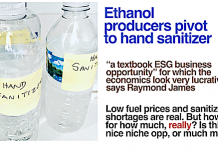by Debra Fiakas, CFA
In recent weeks management from Global Bioenergies (ALGBE: EURONEXT)made the rounds among New York City investors. The French specialty chemical developer is trying to win new friends in the U.S. for its bio-isobutene made through the fermentation of organic materials. Isobutene, also called isobutylene, is a four-molecule hydrocarbon that is a foundational chemical in a wide range of common products from gasoline additives to cosmetics. Until recently, isobutene was made exclusively in the crude oil refinement process. It is one of the many by-products of crude oil refining that helps pad the profit margins of big oil and as companies such as ExxonMobil (XOM: NYSE) and Marathon Petroleum (MRO: NYSE).
The founders of Global Bioenergies, Marc Delcourt and Philippe Marliére, understood the role of bacteria in accelerating the breakdown of organic material in nature’s own refinery – fermentation. The well-known renewable fuel, ethanol, is a typical product of fermentation. Highly caustic and wanting in efficiency in converting organic matter to power, ethanol has limitations. The duo wanted to extract more value from organic feedstock. They also wanted a result that would be compatible with the entrenched fossil fuel supply chain and distribution network. They set a goal for a biologically-based hydrocarbon.
Bacteria may seem simple, but they are particular about their living conditions. It took several years of trial and error before the two scientists finally coaxed some bacteria into producing isobutene in a gaseous state. It was a dramatic breakthrough for the specialty chemicals industry that had never imagined organic hydrocarbons. That might have been the easy part. The years since have been dedicated to getting the bacteria to live in large colonies that can produce isobutene at commercial scale.
Patience has paid off. In 2015, Global Bioenergies completed construction of a pilot plant located at an industrial site near Reims, Germany. The plant has a capacity of ten metric tons. A demonstration site with 100 metric tons production capacity was also built at Leuna, Germany in 2016.
Ready for Commercial Stage
Cristal Union, one of France’s largest sugar producers, is Global Bioenergies first commercial partner. The two have formed a joint venture to build a plant with a 50,000 barrel per year nameplate capacity at one of Cristal’s beet sugar production facilities. The beet sugar process generates ample waste materials that do not make it into the bags of beet sugar. The estimated capital cost to reach commercial production is Euro 115 million, which will be financed through a mix of construction, equipment and project financing. The partners are targeting 2021 for the first commercial shipments of isobutene.
The two companies will run the plant as a joint venture named IBN-One with Global Bioenergies taking the lead in marketing and distribution. The company sees multiple markets for its isobutene. The cosmetics industry makes use of a variety of specialty chemicals for lotions and crèmes and isobutene is widely used for texturing properties. The high octane character of isobutene also makes it useful as an additive to gasoline to boost performance of combustion engines.
Global Bioenergies will earn royalties on the project with the first Euro 5 million payment is due upon plant completion and the onset of production. The company wants to cookie cutter the arrangement around the world with other partners that have a ready source organic material that might otherwise be considered waste.
Acquiring a Ticket to Go Global
The company is looking well ahead to a mix of potential partners. The recent acquisition of Syngip, B.V. with its technology for converting organic material to fuels is expected to make it possible to use a wide range of feedstocks in Global Bioenergies’ proprietary fermentation process. The company has already proven is process at commercial volumes with sugars and cellulosic materials such as straw or wood chips have been proven compatible in the laboratory.
However, Global Bioenergies wants to use third-generation feed stocks such as industrial waste gases. Think of the carbon dioxide and carbon monoxide in the emissions of steel mills. Syngip’s has developed a process to convert gaseous carbon sources to light olefins, the foundation for strong, colorfast fibers with a wide range of uses such as carpeting, ropes or even wallpaper.
As beguiling a concept at waste gas to carpet might be, a partnership with a major steel producer such as ArcelorMittal (MT: NYSE) is quite a way off. Investors should be looking more closely Global Bioenergies current commercialization efforts. In addition to the joint venture with Cristal Union to produce isobutene, the company has collaborations underway to reach end customers: Lantmännen Group’s Aspen, a specialty gasoline producer; bottled gas maker Butagaz SA owned by DCC, PLC (DCC: LSE); and beauty products developer L’Oreal SA (OR: EPA). Car manufacturer Audi and specialty chemicals producer INEOS have also expressed interest in working with Global Bioenergies.
Keys to Success
Turning technology into commercially viable products and reaching customers requires capital. Global Bioenergies is burning about one million Euros per month and will probably not become profitable for several more years. The company recently raised capital and now has an estimated EURO 19 million (US$24 million) on its balance sheet. Management expects its nest egg to support operations and development plans well into 2019. Management has a strong history of successful capital raising efforts and makes a credible argument that new capital can be easily raise when needed.
Once commercial production begins, each joint venture project will have to manage margins between the costs of inputs and selling prices. Global Bioenergies expects its bio-isobutene to command premium prices from customers that want to claim sustainable raw materials in their supply chains. Nonetheless, as a substitute to oil-derived specialty chemicals, the product will be susceptible to the trend in crude oil prices. On the input side, sugar prices will impact the company’s first beet-to-isobutene project in Germany. If successful in making in the leap to cellulosic or gaseous organic materials, the company may get a break on the cost side from zero to low cost feedstock from waste emissions or agricultural waste.
A company can stub its toe when taking the steps from laboratory bench to commercial production and then to the market. Besides capital and a sound business model, the right management skills must be deployed. The problem is that each step takes different talents that are rarely all found a single person. The scientist-product developer-negotiator-marketer is a rare animal, indeed. Even rarer is the scientist-developer who understands when to reinforce the team with a qualified negotiator-marketer. Investors will need to watch closely for early warnings of execution missteps.
Debra Fiakas is the Managing Director of Crystal Equity Research, an alternative research resource on small capitalization companies in selected industries. Neither the author of the Small Cap Strategist web log, Crystal Equity Research nor its affiliates have a beneficial interest in the companies mentioned herein.








